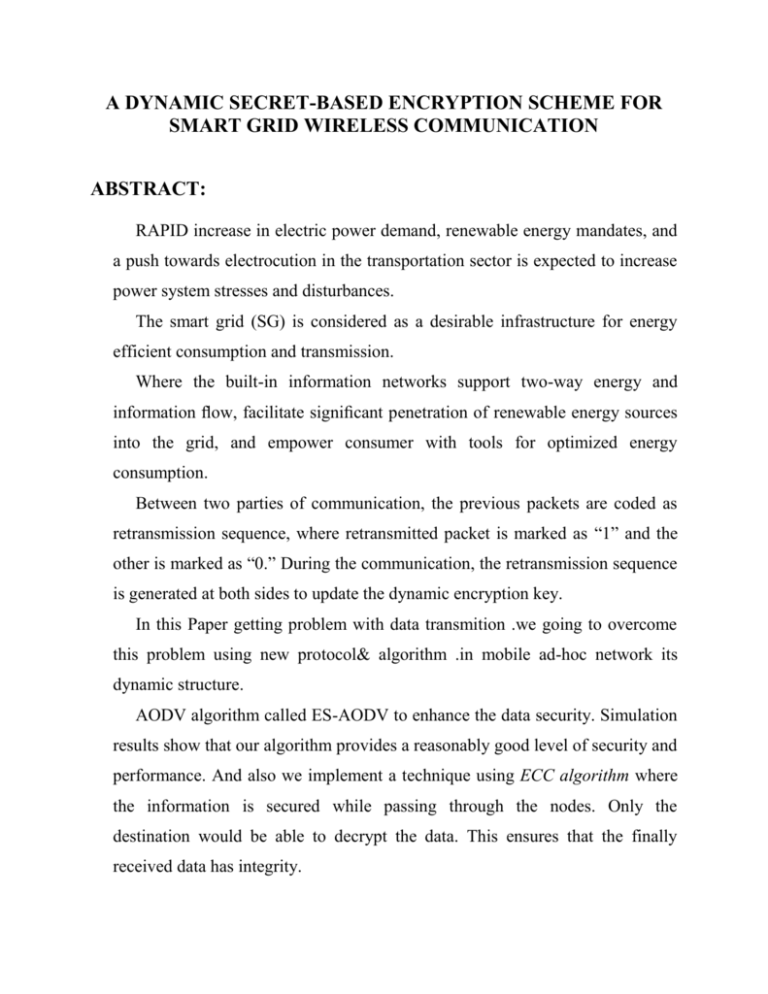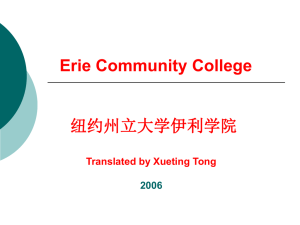3. Contributory Broadcast Encryption with Efficient Encryption and
advertisement

A DYNAMIC SECRET-BASED ENCRYPTION SCHEME FOR SMART GRID WIRELESS COMMUNICATION ABSTRACT: RAPID increase in electric power demand, renewable energy mandates, and a push towards electrocution in the transportation sector is expected to increase power system stresses and disturbances. The smart grid (SG) is considered as a desirable infrastructure for energy efficient consumption and transmission. Where the built-in information networks support two-way energy and information flow, facilitate significant penetration of renewable energy sources into the grid, and empower consumer with tools for optimized energy consumption. Between two parties of communication, the previous packets are coded as retransmission sequence, where retransmitted packet is marked as “1” and the other is marked as “0.” During the communication, the retransmission sequence is generated at both sides to update the dynamic encryption key. In this Paper getting problem with data transmition .we going to overcome this problem using new protocol& algorithm .in mobile ad-hoc network its dynamic structure. AODV algorithm called ES-AODV to enhance the data security. Simulation results show that our algorithm provides a reasonably good level of security and performance. And also we implement a technique using ECC algorithm where the information is secured while passing through the nodes. Only the destination would be able to decrypt the data. This ensures that the finally received data has integrity. EXISTING SYSTEM: In this Existing concepts Cryptography plays a significant role in improving the integrity and confidentiality of the data in SG. Many existing standard encryption algorithms and authentication schemes are adopted in SG. In that cryptography will not give full security to data transmition in wireless network. Wireless network get more problem during packet transmition loss data as well us dropping data, so we can’t able prevent. In this paper having same problem. Symmetric cryptographic such as DES (Data Encryption Standard), Triple DES, AES (Advanced Encryption Standard) are widely employed in SG to efficiently defend against possible threats. This kind of algorithms compare with others very low security. Drawbacks: Unreliability is more when compared to other algorithms. Modified data easily. Use of algorithm for encryption and decryption. Hence communication is Unsecured. Dynamic Key changing was very slow. PROPOSED SYSTEM: In the existing systems AODV routing protocol is used for transmission of data. It is a reactive protocol that requests the route only when it needs. It does not require nodes to maintain routes to the destination that are not communicating. First, a route request is sent and a table is maintained for each node, in which all the route replies are stored. Then the AODV Protocol chooses a path in random from the table and transmits the data. In the existing approach ECC algorithm is being used for encryption and decryption. Therefore communication is secured as the data cannot be viewed while it passes through the intermediate nodes. No node in between can read or views the data. The keys to encrypt and decrypt the data are only known to the source and the destination, respectively. Any node in between, which tries to read this information will not be able to do so because, the information will be encrypted using ECC. Features: • Reliability is more when compared to previous methods. • No modification of data while transmission. • Use of ECC algorithm for encryption and decryption. • Hence communication is secured. • No node in between can read or views the data. • Dynamic key changing time was fast, compare to others Algorithms. SOFTWARE SPECIFICATION: HARDWARE SPECIFICATION: Processor : Intel Pentium III or higher RAM : 1 GB or higher Hard Disk : 40 GB or higher Mother Board : Intel 845 g chipset or higher I/O : Optical mouse and keyboard SOFTWARE SPECIFICATION: Operating system : Linux-Mint15 Programming : Network Simulator 2.35 Language Used : TCL and C++ Network Modeling : Dia or Ns2 Tool ECC ALGORITHM: Elliptical curve cryptography (ECC) is a public key encryption technique based on elliptic curve theory that can be used to create faster, smaller, and more efficient cryptographic keys.ECC generates keys through the properties of the elliptic curve equation instead of the traditional method of generation as the product of very large prime numbers. The technology can be used in conjunction with most public key encryption methods, such as RSA, and Diffie-Hellman. According to some researchers, ECC can yield a level of security with a 164-bit key that other systems require a 1,024-bit key to achieve. Because ECC helps to establish equivalent security with lower computing power and battery resource usage, it is becoming widely used for mobile applications. ECC was developed by Certicom, a mobile e-business security provider, and was recently licensed by Hifn, a manufacturer of integrated circuitry (IC) and network security products. RSA has been developing its own version of ECC. Many manufacturers, including 3COM, Cylink, Motorola, Pitney Bowes, Siemens, TRW, and VeriFone have included support for ECC in their products. Advantages: Small key sizes (with same security). Greater speed less storage. ECC can be used in smart cards, cellular phone and pagers. The ECC is more suitable than RSA algorithm or SDL algorithm The main use of ECC is Key exchange Digital signature Authentication Message transmission











